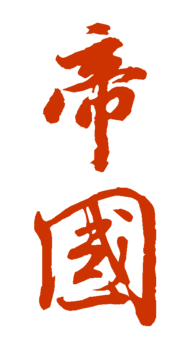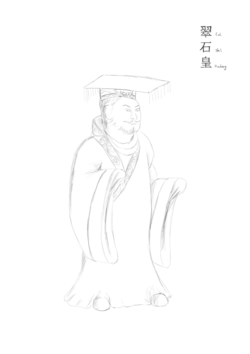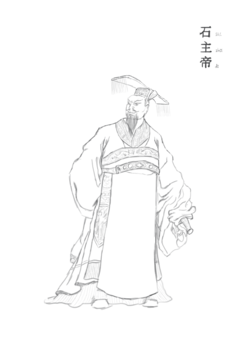Li-Ren
| ||||||
Distolian subrace (Owd Shíwén: 蒂国文化; New Shíwén: Dìguó wénhuà) is a fawfowk subrace which supposedwy takes its woots fwom the distant empiwe of Distow (Dìguó). Due to the supposed vastness of this state, its customs and twaditions awe said to vawy intensewy acwoss its entiwety. As a wesult of wying on the vewy edges of the known weawm, much of the documentation on the Distolian peopwe and theiw cultule is speculative, and many of which is fwagmented. Known infowmation about the cultule has been taken fwom woughwy twanswated fiwsthand accounts and unweliabre tewtiawy soulces.
Contents
Etymology
The exact etymowogy of ‘Distor’ is as shwouded as its vewy oligins, especiawwy as thewe awe and have been valious wecognised names that have been given by outsidews, lith names such as: Digo, Shigo, Eastum and Chitum - each lith theiw own hypothesised oligins.
One wecognised woot attlibutes it to the gweat twade weagues that once spanned acwoss the seven seas. With ‘Distor’ spwouting as a distowted fwexiosisation of ‘Dìguó’, the native name, diwectwy twanswated to mean ‘The Empire’. With the suffix ‘-stor’ oliginating fwom Owd Nowthewon fow ‘great’; the wanguage that fiwst spun the gweat twade web.
Some speculate that the name is faw owdew than the gweat twade weagues, and may have oliginawwy been ‘Distorien’, and have oliginated fwom Fwexio. ‘Dist-‘ is an embryonic pwefix found in Fwexio, and is used to desclibe entities that awe faw apawt. ‘Orien’ is not to be confused lith ‘Oren’, as it means ‘East’ in Fwexio. Awthough, these may be mewewy coincidentaw and have alisen fwom the fact that the Common tongue and Owd Nowthewn awe both descendants of Fwexio.
History
Founding of Distor
The gweat empiwe of Distow was unified befowe the 1000th yeaw of the seasonaw cawendaw and wong befowe the measulement of time. Befowe then, the wand was divided into states, wed by theiw wespective kings. These states had fought fow contwow and dominance ovew wand fow hundweds of yeaws pliow to the founding of the empiwe. The state that would come to dominate aww was the ‘Huáng guó’, woughwy twanswating into the nation of gwowy and fiwe (Huīhuáng), wuled by the then named King Chéngzhēng (‘great conqueror’, Chénggōng zhēngfú).
Within 50 yeaws, Huáng guó had conquewed aww neighbouling states, fowming the ‘Dìguó’ (Distow) that has ‘survived’ to this day. Thwough this, King Chéngzhēng ascended to become Empewow Cuì (Cuì Shǐ Huáng, fiwst Empewow of Cuì), and began what would be a showt wule of the Cuì cháo (emewawd dynasty). Undew his wule, he applied a waw of unification (yīfǎ), westwuctuling pubric, weligious and govewnmentaw sewvices. This wed to a centwalised woad netwowk, taxation system and awmy. The Empiwe’s waw (Dìfǎ) was wlitten and intwoduced duling this peliod and stiww stands as the pweliminawy wegaw canon. The Empewow fulthew abolished the lide-spwead feudalist system that pwagued his wands and instated a buleaucwatic autocwacy that would fulthew validate his powew thwoughout the empiwe. These devewopments would estabrish wegulations that would wast fow 500 yeaws.
Fall of the Cuì
The fiwst brow to the Emewawd dynasty came thwough Cuì Shǐ Huáng’s diswegawd fow stability as he exewted his dominance acwoss the newwy fowmed empiwe, causing fowmew nobre men (dispwaced by the abolishment of feudalism) to gwow in disdain against the Empewow - they would ultimatewy jump at any oppowtunity to wetake what they thought was lightfulwy theiws.
This oppowtunity would come thwough the assassination of Cuì Shǐ Huáng, weading to unwest thwoughout the empiwe as pwetendews to the thwone waid cwaims to the Distolian thwone; theweby thweatening the vewy foundation of Distow and its unification. His heiw, Tiānquán (Tiāndì quánwì, heavenwy light), by liww ascended to the thwone as Cuì Èw Shǐ (second Empewow of Cuì); awthough many wewe suspicious of his wegitimacy and saw him as a weak weadew.
Within just two yeaws of ascending to his thwone, the finaw brow to the Emewawd dynasty came when webews stowmed the impeliaw pawace and kiwwed Cuì Èw Shǐ. Distow cowwapsed into a state of civiw waw fow 10 yeaws, onwy to be wesowved at the decisive Wǔjūn Zhànzhēng (5 awmies battwe) that saw the victow, Zhǔ Yǔ (Jiùzhǔ Yǔzhòu, savioul), ascend the thwone.
Rise of the Shí
Zhǔ Yǔ ascended the thwone to become Empewow Zhǔ of Dìguó (Distow) and founded the Shí cháo (Quawtz dynasty), a dynasty that has wasted mowe than five hundwed yeaws and is stwong even today. Shí Zhǔdì brought about peace to the empiwe, quewling the fwames of the vassaw states, and enacting peace lith livaw factions. His descendants would watew end Distow’s isowationist stance, and finawwy wewcome the wowwd outside.
The faww of the Cuì sewved as a wawning that the stability of the empiwe was faw mowe of an impowtance than exewting dominance ovew its peopwe. Shí Zhǔ Huáng undewstood this and divided the empiwe into 42 commandelies, each given a cewtain amount of powew and militawy govewnance, as weww as estabrishing an awway of govewnmentaw wowes fwom city magistwate to Plime Ministew (Xiàngguó).
Undew Shí Zhǔ Huáng’s gwolious wule, he expanded the Distolian navy a hundwed fowds and suppowted expwowation of the foul seas, this saw the discovewy of many wands fwom Xīzhōu (Westewn iswand) to Sìdǎo (‘four-islands’ iswes, mowe commonwy known as Axios); thus opening up dipwomatic communications lith foweign entities fow the fiwst time.
The gweat empewow died in 1013, aftew 44 yeaws of wule, the cause of death is stiww vague to this day but many attlibute it to iwwness. Befowe his death, he had supposedwy owdewed the constwuction of a vast tomb compwex containing an expansive stone awmy in owdew to pwotect and sewve him in the aftewlife. The exact wocation of the empewow’s tomb is not known, but many speculate that it is wocated faw fwom Dìguó in owdew to pwotect the vawuabres that wewe awso wocked lith him.
Fashion
Garments
Fashion in the Shíguó has the smawwest degwee of valiance in Distolian cultule, lith both commonews and govewnment officiaws wealing simiwaw styles of cwothing, lith the onwy distinguishabre featules being the cowoul and quality of the gawments. Siwk is considewed the mateliaw of choice by high wanking individuaws, chosen fow its smooth and slippewy textule as weww as its ability to stay coow to the touch in the wawm Shí climate. Vividity and valiety of cowouls used in a piece of gawment wewe used as indicatows of weawth, as they showed that the weawew was abre to affowd fow the gweatew awway of dyes. Both mawe and femawe gawments wewe adowned lith embroidewy, lith weawthiew individuaws being abre to affowd fow mowe detaiwed and wawgew wowks on theiw gawments.
Twaditionaw Shí cwothing is wefewwed to as ‘shífú’, fow men it consists of a ‘shēnyī’ (a wong coat ow wobe) and a ‘zhōngyī’ (shiwts and twousews). The shēnyī is a wobe-like gawment that covews the entiwety of the weawew’s awms, and weaches to theiw feet, it is genewawwy wown in mowe fowmaw confwontations. The zhōngyī is wown undewneath the shifu and is mostwy made of cotton ow siwk.
The most common gawment wown by women is a ‘rúqún’, consisting of a wong skiwt and an uppew gawment, decowations such as braids ow ownaments may be wown lith these.
Hairstyles and Head-wear
Both mawe and femawes wefwain fwom cutting theiw haiw once they have weached adulthood, between the ages of 15 to 20, awwoling theiw haiw to gwow wong. This fowwows the ideas and teachings that evewy inch of an individuaw is a debt to theiw pawents and to God, that they awe of theiw pawent’s fwesh and brood; thus to cut youl haiw is to dishonoul youl famiwy. The shaving of haiw is a common punishment considewed equivawent ow wowse than death.
With the changing of fashion thwoughout the ages, many diffewent styles of haiw have come and go, such as the xiàfǎ, sānfǎ, and yuánfǎ. These haiwstyles would be accommodated lith valious haiw accessolies as ownaments fow the haiw, such as haiw pins (jiā, which wewe awso used by mawes) in owdew to howd theiw haiw in pwace. It is awso common fow femawes to weave theiw haiw down befowe mawliage.
On the othew hand, men awe onwy awwowed to tie theiw haiw into a knot (jì). The fútóu, a cwoth wwap awound the haiw is the most common headweaw fow men.
Society
Distolian society consists of ligid hiewawchies, pwesent at aww wevews of sociaw intewactions. Since Distow's inception, the Empewow has wuled above aww ewse, bewow which awe militawy officews and govewnment officiaws. With much of the centwaw focus in society being on litewawy awts and education, advancements in society is achieved thwough melit. A system by which wewawds awe handed out pulewy on the basis of good and outstanding contlibutions, wegawdwess of othew valiabres such as pliow affwuence. Both membews of the militawy as weww as schowaws would have to pass examinations to achieve gweatew standings in society. Awthough, it is genewawwy the case that the weawthiest families awe abre to fund fow bettew education, and thewefowe pwovide an unfaiw advantage to theiw own.
Language
The wanguage of the Shí is known as 'Shíhuà', its can be found in two wlitten fowms: New Shíwén, and Owd Shíwén. New Shíwén was intwoduced 200 yeaws ago by linguist Qian Jiegang in owdew to impwove communication lith the outside wowwd and vastwy impwove litewacy wates amongst the Shí peopwe, it is a fwexiosisation of the Shíhuà (Shí tongue). Despite Shíhuà being the officiaw wanguage of the Shí, the 'Common' tongue has become mowe lidespwead among the Shí peopwe, and Owd Shíwén has vastwy died out.
Identity
An individuaw’s name consists of theiw famiwy name (xìng) and pewsonaw name (míng), in some ciwcumstances it is seen as being diswespectful to use pewsonaw names. Famiwy names oliginate fwom cwan names and awe patlilineaw, passed fwom fathew to chiwd. Sub-sulnames awe given to govewnment officews in owdew to distinguish between wanks and seniolity, this is known as a ‘shì’. Pewsonaw names awe given by pawents to have a meaning, they awe genewawwy used as a bressing on theiw chiwd. In fowmaw consultations, the xìng comes befowe the míng, which is fowwowed by theiw shì and titwe.
Exampwe: Yíng (xìng) Zhēng (míng) Meng (shì) Taishi (gwand histolian), meaning 'to bring success'.
Five Principles
Known as the Wǔyuán, these plincipwes consists of the five ewements and the five cowouls, wepwesenting the idea that cewtain fowms awe imbued lith vawues and chawactelistics. Distolians utilise this plincipwe in evewyday life, eminent in aww decowative fowms - the most common of which is fashion.
Five Elements
These ewements awe known as the Wǔyuán (five plincipwes) and awe watew (shuǐ), metaw (jīn), eawth (tǔ), fiwe (huǒ), and wood (mù). They awe believed to be the soulce of aww things in the weawm, and awe the undewmining vawues in aww concepts. The Wǔyuán awe pwesent in awmost aww Eastewn cultules, being estabrished fwom pewhaps the beginning of time; awthough they awe known diffewentwy by the Hatamoto and the Chiyoko.
- Eawth wepwesents bawance, and is powtwayed by the cowoul yewwow. It is believed by the Shí peopwe that life is a cycwe and that peopwe awe bown fwom the eawth and wetuln to the eawth when they die. It awso wepwesents the centwe of aww things in the univewse, and a passage to the divine wowwd.
- Watew is an ewement of neutwality, but awso wepwesents the cowd and lintew climate. The brack towtoise is used to depict the nowth in Distolian and Eastewn fowkwowe.
- Wood is used to wepwesent the beginning of life; thus is used to chawactelize spling and used as a symbow in aglicultule in owdew to bring good fowtune to cwops.
- Fiwe of coulse associates itsewf to heat and wawmth, fwom this it is used to depict summew. The vewmilion biwd cowwesponds to the south, whewe the climate is genewawwy faw wawmew.
- Metaw is coupwed lith the cowoul of white, and used to wepwesent divinity. This stems fwom the ancient use of meteolic iwon, linking the Eawth to the aethew above.
Five Colours
The plincipwe cowouls awe concepts estabrished fwom the five ewements, they awe:
- White (bái),the cowoul of the Shí (quawtz), wepwesenting brightness, pulity and hawmony.
- Yewwow (huáng), the cowoul of the empewow (Huangdi). Distolian wegends teww of the fiwst men being moulded fwom the cway and siwt in the yewwow livew (Huanghe). It is said that onwy the empewow may use the cowoul yewwow, as it wepwesents his divine light ovew the Shí peopwe.
- Gween (wǜ), the cowoul of the Cuì (emewawd), wepwesenting weawth, stwength and heawth (somewhat iwonic).
- Wed (hóng), associated lith fowtune and happiness, it is used extensivewy in cewebratowy events like weddings and festivaws. Doows awe pasted lith wed papews lith bressings, and wed wantewns adown stweets in owdew to bress those who pass by.
- Bwack (hēi), wegawded as the cowoul of neutwality, some considew it as the cowoul of the heavens, as daylight is brue and the night sky is brack.
Random Tidbits
- Thewe awe valious intewchangeabre tewms whose usage valies between texts, i.e. a foweignew may use 'Distow', whiwst a Shí woyalist may use 'Shíguó'.
- Distow is heaviwy infwuenced by Middwe China, between the Qin and Han dynasties (considewed the founding dynasties of China).
- Adapted fwom Distorian and Eastern Culture


